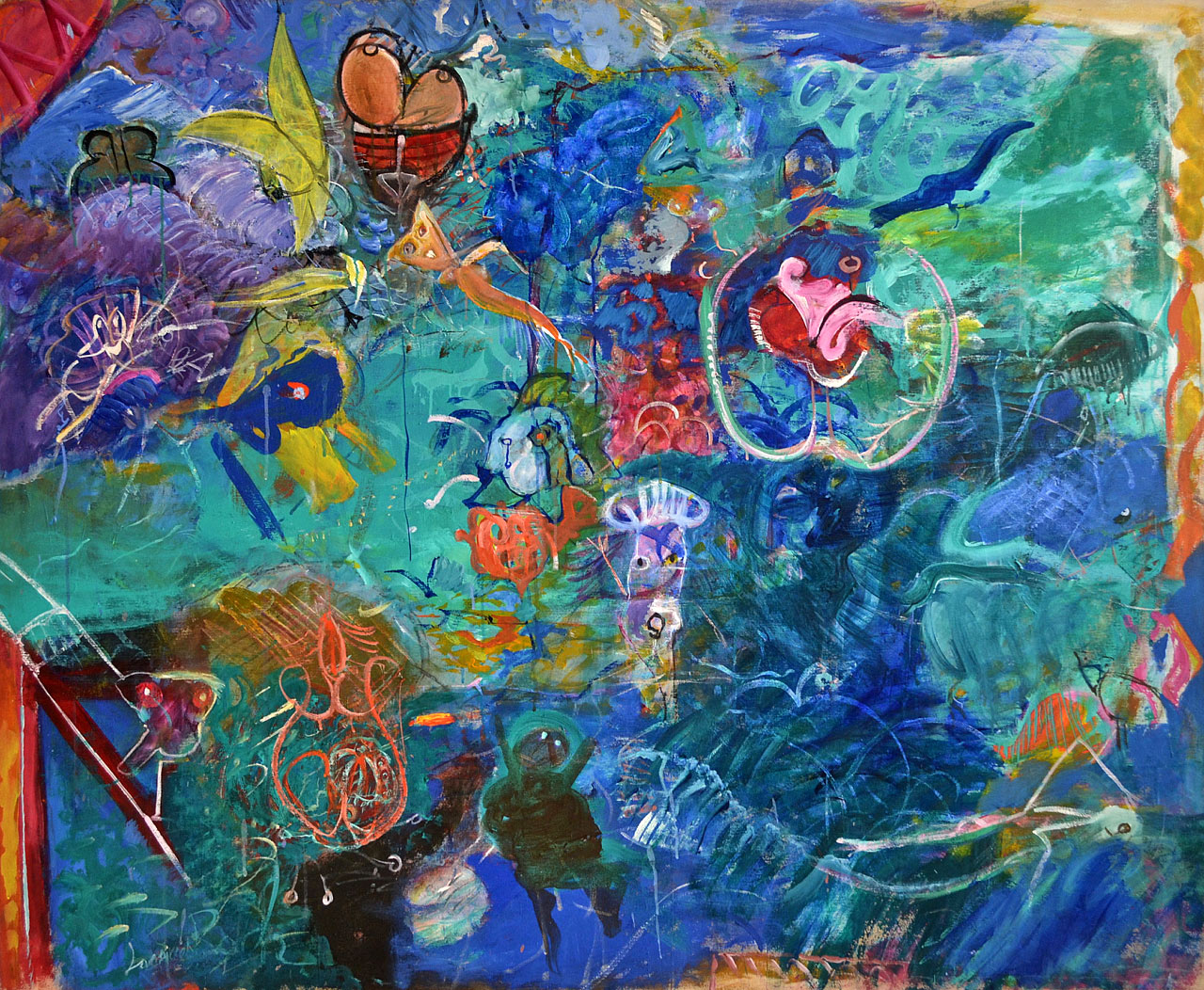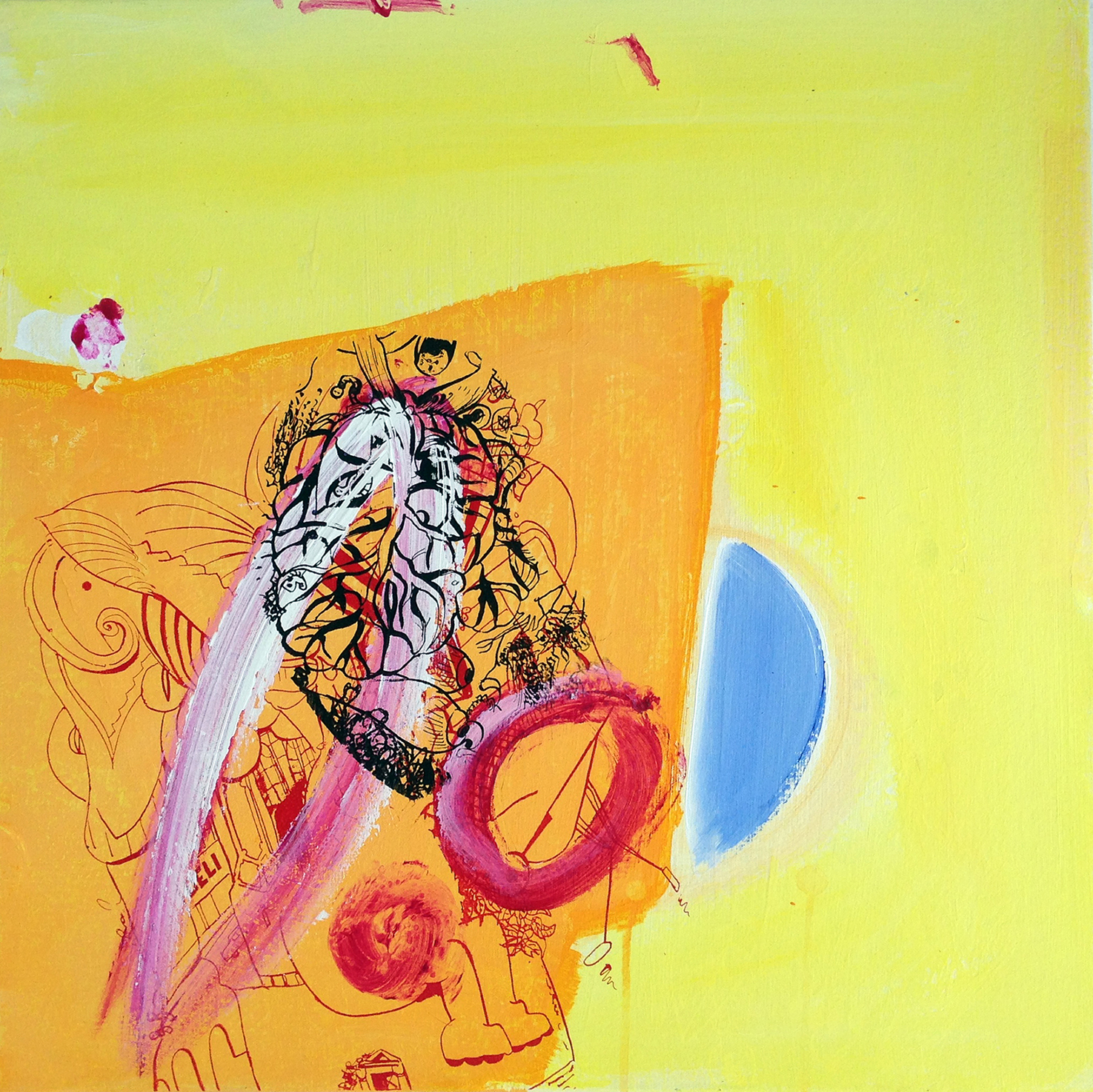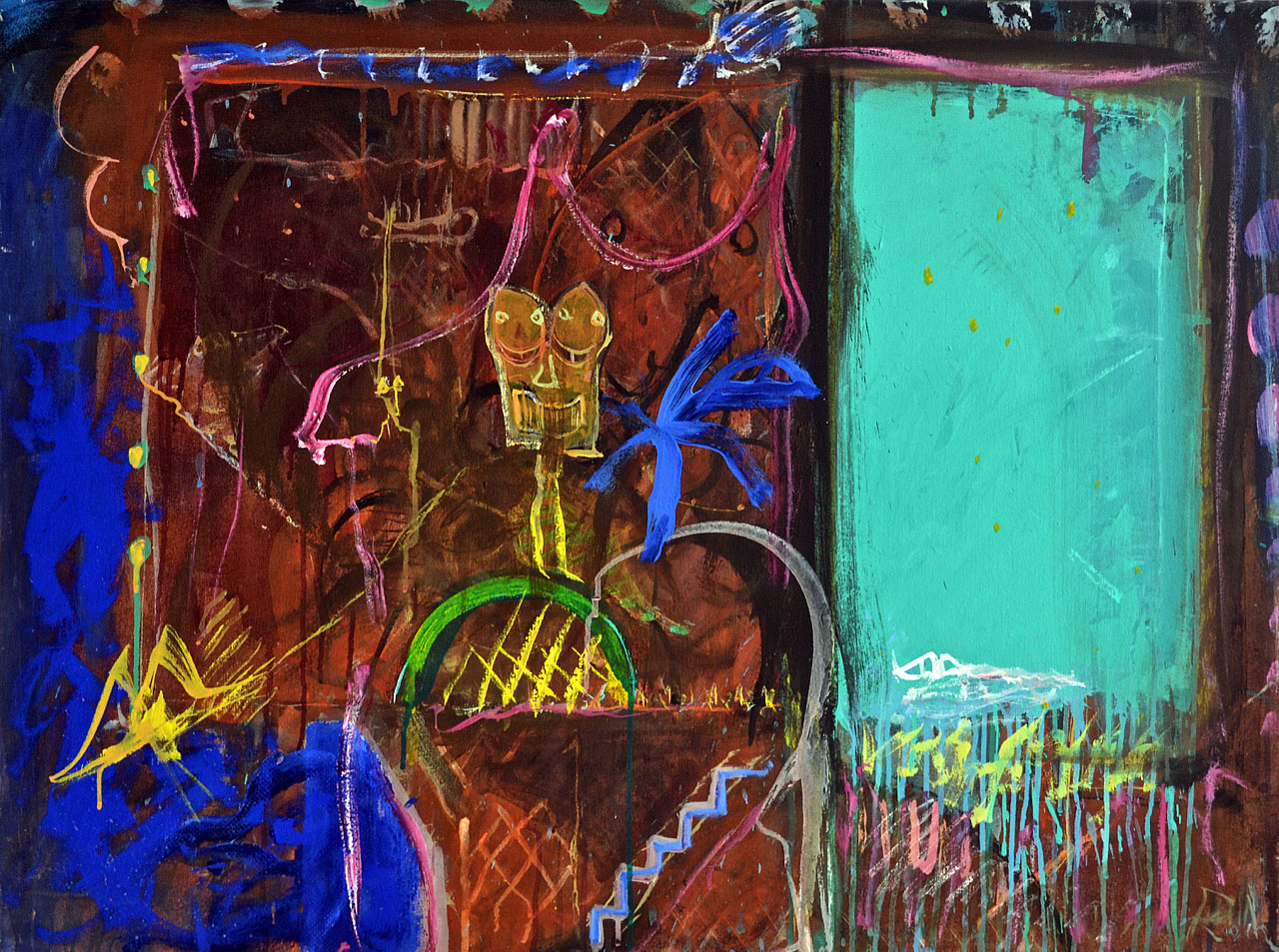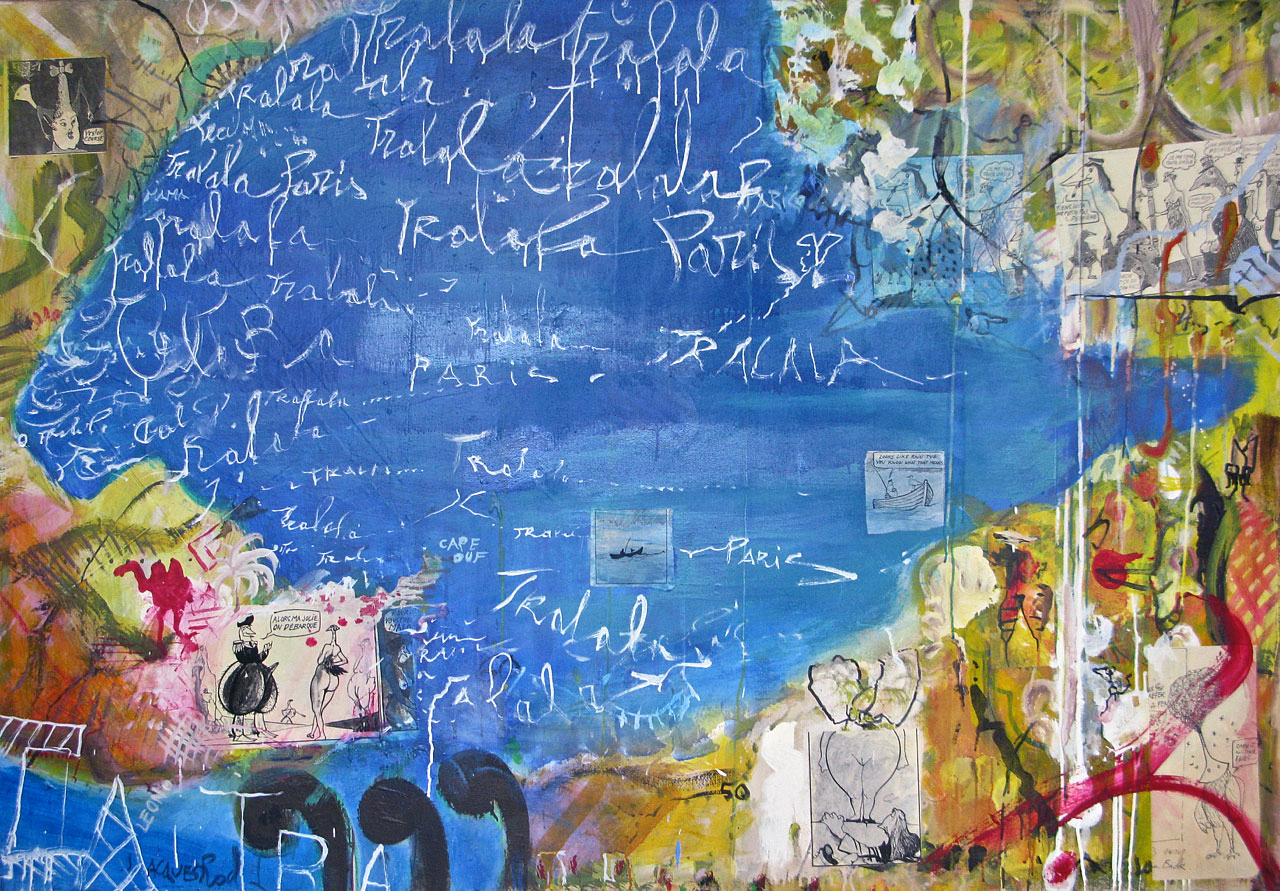by Dominique Nahas

The current exhibition at Kim Foster Gallery in New York City allows us to experience the states-of-mind that pre-occupied, and occupied the late, remarkable artist Jacques Roch (1934-2015). In his notes Roch writes: “… I was born with the condition of the wide-awake dreamer…. The drawn line, clear on a colored ground, held the systems of shapes like a luminous net. The slapstick mood and lushness of color rendered less threatening my private bestiary of violent instincts, bawdy manners, diffuse fears, contagious glee, and even, sometimes, serenity…” This extraordinary exhibition, at the onset of 2019, offers the viewer an unparalleled opportunity to see the development of Roch’s range and styles and his openness to experimentation and change. The show presents nine works on view. They include a selection of previously unseen drawings from the 1970’s, four major paintings from the mid 1980’s, two early works from the 1990’s (Ma Jolie and Love Story) and concluding with two small, intense realized paintings dated 2013: Lucky Knight and La Belle Dame.

If one were to point to one facet of continuity in his work it would be the remarkable musicality of Roch’s private fantasy-worlds, emerging through a highly structured and rigorously spontaneous art, where a sensuous control of radiantly vibrant tonalities in his paintings seem to glow from within. These tonalities illuminate his digressionary visual cadences comprised of small, intricately detailed pen-and-ink fantasy creatures and spaces whose features and renderings were not so much sung or recited but scatted – the visual equivalency of vocal improvisation of jazz singers using nonsense syllables, improvised melodies and rhythms while using the voice to mimic an instrument. Roch drew and painted his irreverent frenzies, mischievously, as in a reverie. This vision, with all of its unexpected freshness, shows Roch’s profound awareness of the advocacies of chance and the delimitations of the improvisational forwarded by Marcel Duchamp and John Cage.
![Jacques Roch, [paper] 1970's](https://v2.dartmagazine.com/wp-content/uploads/2018/12/paper-1970s-2.jpg)

Jacques Roch lived and worked for decades in a gritty, plank-floored, light-and-plant-filled fourth-floor walk-up and floor-through apartment that substituted, with its torn-down walls, for a modest semblance of the converted industrial lofts that were being colonized across the river by the nascent art scene-sters at the time in Manhattan’s once-abandoned Soho area. In that south-of-Houston Street district, soon-to-be international art stars and their equally prestigious dealers like Sonnabend Gallery, Paula Cooper Gallery, and Leo Castelli Gallery (among many others) were capturing, rightfully, the international news limelight. By contrast Jacques Roch was an early pioneer of the Brooklyn Williamsburg scene, then in its infancy. He was in place there years before Brooklyn became recognized by the media, by the market, by Hollywood, as a vanguard art community. Roch was a Romantic and an Absurdist rolled up into one complex, lovely soul. To complicate/implicate things even more I’d say he had leanings that were temperamentally and oppositionally divided by Arcadian and Utopian impulses. He was a traveler at heart, always on the go psychically, emotionally, intellectually, sensorially. He savored the erotic and the exotic and he discovered these in unlikely places. Roch sought in his own uniquely non-dogmatic way to seek a return to an innocent past and a desire to press forward to a perfected future – a future in which a sensualized heterogeneity and an eroticized heterological co-exist in some space in the mind, where incompatibilities reign supreme.
Jacques Roch loved living in the United States as an expat from France. A true flaneur he celebrated diversity and plenitude, and welcomed incongruities, the unexpected, the non-fitting. These contrarian tendencies were aided and abetted by the opulence and sensuous radiance of his diverse, ribald sign-systems, his often-mischievous forms and his colors. In his paintings meaning risks losing the battle to the unforeseen and to contingency, scattered disseminations, dispersals, digressions and divagations of form and content. Turbulent sensuousness ensues in his drawings and paintings. Roch had a preternatural awareness of digressionary plenitude and was a master player of the impishly impertinent and the metamorphic.

In these selected artworks extending over decades we feel from the very beginning that Roch engendered an intense vision of play-filled lubricity and turmoil, topped-off with a mixture of frenzy and sensuous delight. His complex vision, while it entices and charms with its surfeit of jitteriness and pliability, has equal parts smoothness and scratchiness and darkness. His imagery (like gnats buzzing at your face, a thousand little tongues haptically engaging your eyes and mind) offers us something strangely comical, yet insistently askew. His feverish imagery (a lot of encrypted doodles, naughty bits, monsters and imaginary beasts, private formulations pertaining to the insouciant pleasures of voyeurism and the carnal) straddle coherency and chaos, control and dissolution. What is astonishing to experience as a viewer is Roch’s aliveness to that liminal consideration where coherence and incoherence coalesce. His controlled dissolutions suggest sprawling, proliferating mini-universes of marks and lines, engaging the eye with conditions of mutability and alterity. Roch’s manic, zany linear iterations and re-iterations fragment and coalesce in alternating arrhythmia; his graphic and painterly surfaces recall voluble, energetic force fields of automatic gestural graphism and of writing propelled by surges of involuntary memory.
The French philosopher Gaston Bachelard, in one of the essays entitled L’invitation au voyage (Invitation to Travel) that forms part of his 1943 collected essays “L’air et les songes” (Air and Dreams) writes movingly on poetic expression and its grounding in what he calls “…. the immanence of the imagination in the real, the continuous passage from the real to the imaginary…” Bachelard makes observations that seem remarkably well suited to describe Jacques Roch’s unique aesthetic susceptibility of fusing differences, of exalting the dismantling of a universe as an intricately related activity as the creation of one, of attempting to emerge in a new place, in an unforeseen and unforeseeable place as different as possible from the place you started from. In this sense it’s perhaps right to legitimately consider Jacques Roch’s aesthetic vision a radiant and exalted ode to visual vagabondage. In this sense the vagrant–like way his mind worked, aesthetically speaking, exemplifies the creative faculty described by Bachelard. The French philosopher writes (as if using Roch a case-study to present his findings):“…Imagination is always considered to be the faculty of forming images. But it is, rather, the faculty of deforming the images offered by perception, of freeing ourselves from the immediate images; it is especially the faculty of changing images. If there is not a changing of images, an unexpected union of images, there is no imaginative action if a present image does not recall an absent one, if an occasional image does not give rise to a swarm of aberrant images, to an explosion of images, there is no imagination…The value of an image is measured by the extent of its imaginary radiance. Thanks to the imaginary, the imagination is essentially open, evasive. In the human psyche, it is the very experience of openness and newness…”

Brilliant article by Mr Nahas. It captures the intangible essence of my friend Jacque Roch’s work; which makes it special!